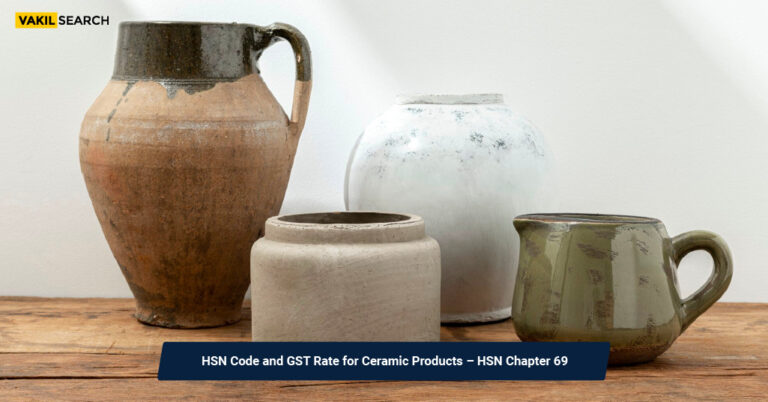With the introduction of GST, many have been confused and wondering how it affects the price of their rice, wheat, barley and other cereal purchases. The HSN code of a product is a way to identify if it is taxed under GST or not and this article explains what exactly that means.
Introduction on HSN Code and GST Rate
The Harmonized System of Nomenclature (HSN) code is an internationally recognized classification system for goods developed by the World Customs Organization (WCO). Each product is assigned a unique HSN code, comprising six to ten digits, which facilitates uniform classification for customs authorities, exporters, and importers. This system streamlines international trade by enabling consistent categorization of goods, aiding in determining applicable tariffs, duties, and trade regulations. We will read more about HSN code and GST rate.
With the implementation of the Goods and Services Tax (GST) in India, the importance of HSN codes has increased. Businesses are mandated to use HSN codes to classify goods for GST purposes. This ensures systematic tax assessment and compliance with GST regulations. Additionally, GST rates are determined based on HSN codes, which categorize goods into different tax slabs, such as 5%, 12%, 18%, and 28%. Understanding the HSN code and corresponding GST rates is crucial for accurate tax calculation and compliance, facilitating transparent and efficient tax administration in India.
What Is the HSN Code?
The HSN code is a unique series of numeric code assigned to a product by the Indian government. It uniquely identifies a product in the country and is used for taxation and trading purposes. Every product and cereal generally contains a HSN code; wheat HSN code for example.
What Is the GST Rate?
The Goods and Services Tax (GST) is a tax levied in India on traded goods and services. The GST was introduced on 1 July 2017 with the aim of creating a single tax system across the nation. The GST rate for rice, wheat, barley and other cereals is 12%.
Is There a Difference Between HSN Code and GST Number?
HSN Code, for example, wheat HSN code, is the product identification code assigned by the Indian government to identify the originating country of a product. GST Number is the tax identifier assigned by the Indian government to identify a product subject to tax under the GST regime. The two codes may look similar, but there is a significant difference between them.
Under the GST regime, all goods and services are taxed at a unified rate of 12%. The HSN code identifies the product as originating from India, while the GST number identifies it as being subject to Indian tax. For example, if you purchase a packet of rice from an online retailer in India, its HSN code would be ‘IN-20849’, while its GST number would be ‘19’.
The Harmonized System of Nomenclature (HSN) code is a standardized system for classifying goods and services. The HSN code provides a common framework for communication between businesses and helps to ensure accurate invoicing.
Use our GST calculator to Calculate GST amount to be paid before registering for GST.
Import Policy for Rice, Wheat and Cereals
The import policy for rice, wheat, and cereals in a country typically involves regulations and guidelines set by the government to manage the importation of these commodities. These policies are formulated to ensure food security, stabilize domestic prices, and protect the interests of local farmers and consumers. Import policies for rice, wheat, and cereals may vary from country to country, but some common aspects include:
- Tariffs and Duties: Governments may impose tariffs, duties, or import taxes on the importation of rice, wheat, and cereals to control the influx of foreign produce into the domestic market. These tariffs are often adjusted based on factors such as domestic production levels, market demand, and international prices.
- Import Quotas: Import quotas may be implemented to limit the quantity of rice, wheat, and cereals that can be imported within a specified period. Quotas are often set based on domestic demand, production levels, and government objectives related to food security and self-sufficiency.
- Quality Standards: Import policies may include stringent quality standards and regulations to ensure that imported rice, wheat, and cereals meet the required health, safety, and quality standards set by the government. Imported commodities may be subject to inspection and certification procedures before they are allowed into the country.
- Licensing and Permits: Importers may be required to obtain licenses or permits from the government before importing rice, wheat, and cereals. These licenses may be issued based on certain criteria, such as compliance with import regulations, payment of duties and taxes, and adherence to quality standards.
- Trade Agreements: Import policies for rice, wheat, and cereals may also be influenced by international trade agreements and negotiations between countries. Governments may enter into bilateral or multilateral agreements to facilitate the importation of these commodities or to address trade barriers and restrictions.
When to Use HSN Code and GST Rate?
When you are buying rice, wheat, barley, and other cereals in India, it is important to use the Harmonized System (HSN) code and the GST rate. Here is a guide to both:
HSN codes are used to classify products according to their manufacturing country of origin. The HSN code for rice is 90011090. The GST rate for this product is 18%.
- The HSN code for wheat is 90011390. The GST rate for this product is 24%.
- The HSN code for barley is 90031180. The GST rate for this product is 18%.
- The HSN code for other cereals (e.g. oats, corn) is 90121110. The GST rate for this product is 18%.
The other popularly known HSN codes for rice, wheat, barley and other cereals in India are as follows:
- Rice: 85391090
- Wheat HSN code: 85041010
- Barley: 85411010
- Other Cereals: 85239090
General Rules on Using HSN Code and GST Rate
India has a nationwide Goods and Services Tax (GST) system. The GST rate for rice, wheat, barley and other cereals will depend on the state in which you are buying the product. Here are the general rules: CTR: The GST rate of rice, wheat, barley and other cereals will be ₹ 18 per kg. RSP: The GST rate of rice, wheat, barley and other cereals will be ₹ 1.5 per kg. At the same time the government has also clarified that pulses and oil seeds are not liable to any additional taxes under GST regime.
The Impact of HSN Code and GST in Import and Export in India
HSN codes are unique identifiers for a product. These codes help in tracing the products from the farm to the store and can be used for Import and export purposes. GST (Goods and Services Tax) is a tax levied by the Indian government on various goods and services. The GST rate for rice, wheat, barley and other cereals is 18%.
The introduction of HSN codes and GST has made importing and exporting food products much easier. It is now possible to trace a product back to its source, which can help in illegal exports or imports. The use of HSN codes and GST also makes it easier to charge taxes on food items.
Conclusion
Thank you for reading our article on HSN Code and GST Rate for Rice, Wheat, Barley and Other Cereals in India. In this article, we have elaborately discussed the different codes that relate to rice, wheat, barley and other cereals in India. We also have provided a list of the GST rates applicable to these items. Hopefully, this information will be useful to you as you shop for groceries online or at brick-and-mortar stores in India.
FAQs
What is the HSN code and GST rate for rice in India?
The HSN code for rice is 1006, and it attracts a GST rate of 0%. Rice is categorized as a zero-rated commodity under GST, meaning it is exempt from GST.
What is the HSN code and GST rate for wheat in India?
The HSN code for wheat is 1001, and it also attracts a GST rate of 0%. Similar to rice, wheat is exempt from GST and falls under the zero-rated category.
What is the HSN code and GST rate for barley in India?
The HSN code for barley is 1003, and it falls under the 5% GST rate category. Barley is taxed at a GST rate of 5%.
What other cereals fall under the 5% GST rate in India?
Apart from barley, other cereals such as oats, maize (corn), millets, and sorghum (jowar) also fall under the 5% GST rate category.
What is the HSN code for cereals, and are there varying GST rates for different types of cereals?
The HSN code for cereals is 1001 to 1008, covering various types of grains and cereals. While most cereals, such as rice and wheat, are exempt from GST (0% rate), certain cereals like barley are taxed at a 5% GST rate. The GST rates for cereals may vary depending on the type of cereal and its classification under the GST regime.
Also, Read:










